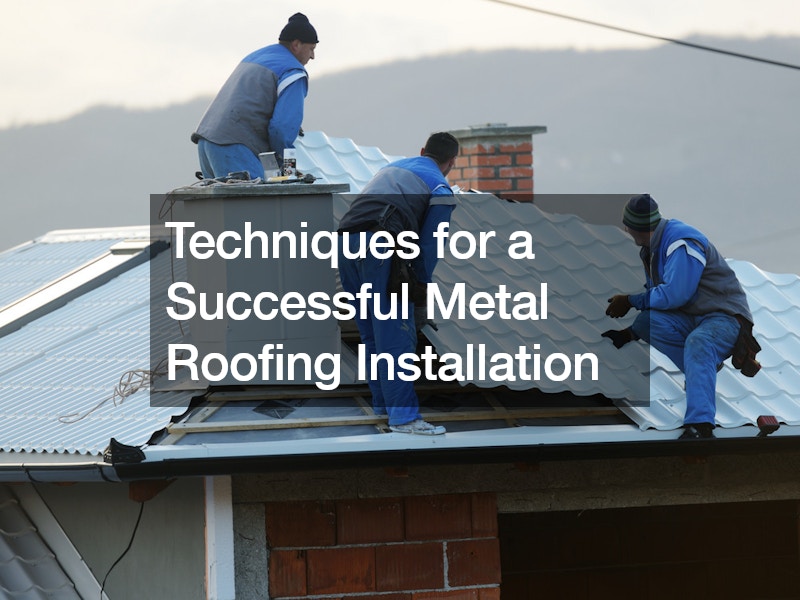
Metal roofing is becoming increasingly popular for residential and commercial properties due to its durability, longevity, and energy efficiency. However, a successful installation requires more than just laying down panels. It involves a series of meticulous techniques to ensure the roof’s longevity and performance. Here are some essential techniques for a successful metal roofing installation.
Proper Roof Preparation:
Before beginning the installation process, it’s crucial to prepare the roof surface adequately. This includes inspecting for any underlying issues such as leaks, rot, or damage to the existing roof structure.
Additionally, ensuring that the roof deck is clean, dry, and free of debris will promote better adhesion and prevent moisture-related problems in the future.
Accurate Measurements and Layout:
Precision is key when it comes to measuring and laying out the metal roofing panels. Taking accurate measurements of the roof’s dimensions and angles will help minimize waste and ensure a seamless fit. Using layout tools such as chalk lines and measuring tapes will aid in marking the placement of panels, ensuring a uniform and visually appealing installation.
Furthermore, it’s essential to consider the roof’s pitch and slope during the layout process. Different roof pitches may require specific installation techniques or panel profiles to accommodate water runoff effectively. By understanding the dynamics of the roof’s slope, installers can determine the optimal placement and orientation of the metal roofing panels to maximize both aesthetic appeal and functional performance. Additionally, accounting for any architectural features or obstructions on the roof surface during the layout stage can help avoid complications during installation and ensure a smooth, professional-looking finish.
Choosing the Right Fasteners:
Selecting the appropriate metal roofing fasteners is essential for securing metal roofing panels effectively. Using high-quality screws or nails specifically designed for metal roofing will ensure proper attachment and minimize the risk of rust or corrosion over time. Additionally, determining the correct spacing and placement of fasteners according to the manufacturer’s guidelines is critical for structural integrity and wind resistance.
Moreover, considering the environmental factors is crucial when choosing fasteners. For example, if the installation site is in a coastal area or a region prone to high humidity, selecting fasteners with enhanced corrosion resistance, such as stainless steel or coated screws, becomes imperative. These specialized fasteners offer greater durability and longevity, ensuring that the metal roofing system remains securely fastened and protected against the corrosive effects of moisture and salt air.
Proper Panel Installation:
When installing metal roofing panels, it’s essential to start from the eaves and work your way up towards the ridge. This ensures proper water drainage and prevents moisture infiltration under the panels. Additionally, overlapping each panel correctly according to the manufacturer’s specifications will create a watertight seal and enhance the roof’s resistance to leaks and weather damage.
Sealing and Flashing:
Proper sealing and flashing around roof penetrations, such as chimneys, vents, and skylights, are crucial for preventing water intrusion and maintaining the roof’s integrity. Using high-quality sealants and flashing materials compatible with metal roofing will ensure a durable and weather-resistant seal around these vulnerable areas.
Additionally, paying attention to the details during the sealing and flashing process is essential for achieving optimal results. This includes meticulously applying sealant around the edges of flashing components and ensuring a snug fit to prevent water from seeping into gaps or crevices. Also, inspecting the flashing regularly for signs of wear or damage and promptly addressing any issues will help prolong its effectiveness and prevent potential water damage to the roof structure.
Ventilation and Insulation:
Ensuring adequate ventilation and insulation in the attic space beneath the metal roof is essential for maintaining indoor comfort and preventing moisture buildup. Proper ventilation helps regulate temperature and humidity levels, reducing the risk of condensation and mold growth. Installing insulation also improves energy efficiency and reduces heating and cooling costs.
Apart from temperature regulation and moisture control, proper ventilation and insulation play a crucial role in preserving the structural integrity of the entire building. Without adequate ventilation, excessive heat buildup in the attic can lead to premature deterioration of roofing materials and structural components. Furthermore, trapped moisture can cause wood rot, corrosion of metal components, and compromise the effectiveness of insulation.
Regular Maintenance:
Once the metal roof installation is complete, regular maintenance is necessary to prolong its lifespan and performance. This includes inspecting the roof periodically for signs of damage, cleaning debris and debris buildup, and addressing any issues promptly to prevent further damage or deterioration.
To conclude, a successful metal roofing installation requires careful planning, precision, and attention to detail. By following the techniques outlined in this guide, homeowners and contractors can ensure a durable, weather-resistant, and aesthetically pleasing metal roof that will provide years of reliable protection for their property. Whether it’s proper roof preparation, accurate measurements, or correct panel installation, every step plays a crucial role in achieving a successful outcome. With the right techniques and a commitment to quality, a metal roof can offer unparalleled durability and performance for decades to come.
.

